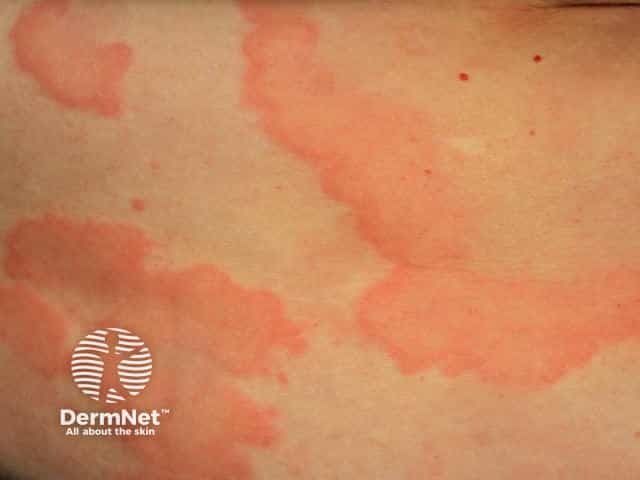
A recent systematic review and meta-analysis published in Clinical and Translational Allergy by Konstantinou et al investigates the role of genetic and epigenetic factors in the development and progression of acute and chronic urticaria (CU). By comprehensively analyzing 61 studies spanning a variety of genetic markers, the research offers valuable insights into potential hereditary susceptibilities and pharmacogenetic predictors in urticaria, a condition known for its variable response to treatment and significant impact on quality of life.1
“This systematic review and meta-analysis emphasize the significant role of genetic factors in the pathogenesis, diagnosis, and treatment of CU,” researchers behind the review said. “Key findings include the identification of significant associations between genetic polymorphisms—such as those in HLA-B44 and VDR genes—and disease susceptibility, highlighting the potential for genetic biomarkers to improve diagnostic precision and guide personalized therapeutic strategies.”
Background
Urticaria is categorized into acute (<6 weeks) and chronic (≥6 weeks) forms. Chronic urticaria, which includes chronic spontaneous urticaria (CSU) and chronic inducible urticaria (CIndU), affects approximately 1% of the population.2 Despite its prevalence, the pathophysiology of CU remains complex and incompletely understood. Mast cell degranulation via autoimmune and autoallergic mechanisms underpins the clinical manifestations, but many patients remain refractory to treatment, suggesting underlying molecular contributors.3
Methods
Following PRISMA guidelines, the authors searched PubMed, Scopus, and Web of Science up to July 31, 2024, including original human studies evaluating genetic or epigenetic associations with any urticaria subtype. Eligible studies ranged from genome-wide association studies (GWAS) to case-control and cross-sectional designs. A meta-analysis was conducted using random-effects models where three or more comparable datasets were available. The Newcastle-Ottawa Scale was employed to assess the risk of bias in observational studies.
Key Findings
The review highlights several genetic markers significantly associated with CU:
HLA-B44 emerged as a strong risk allele, conferring an eightfold increase in susceptibility (OR 8.15; 95% CI 1.61–41.29), albeit with high heterogeneity (I² = 86%).Vitamin D receptor (VDR) polymorphisms—notably FokI, TaqI, and BsmI—were linked to a 1.5 to 2.1-fold increased risk of CU.FcεRIα and CRTH2 gene variants were associated with altered response to antihistamines, pointing to potential pharmacogenetic relevance.Overexpression of immune-related genes, including FCER1G, IL-6, PTGS2, CCL2, and TNF-pathway genes, in lesional skin supported an autoimmune etiology.
In addition to identifying susceptibility loci, the review underscored that CSU patients often harbor comorbid autoimmune conditions, especially autoimmune thyroiditis, further reinforcing the autoimmune-genetic overlap.
Gaps and Limitations
Despite robust findings for CSU, evidence for genetic associations in non-CSU subtypes and acute urticaria was limited. Moreover, researchers noted the literature on epigenetic regulation and gene-environment interactions in urticaria remains sparse. The heterogeneity in study designs, population ethnicity, and outcome definitions also complicates meta-analytic synthesis for many candidate genes.
Clinical Implications
This review supports the concept that CU, particularly CSU, is genetically and immunologically distinct, sharing features with systemic autoimmune diseases. HLA-B44 and VDR polymorphisms may serve as risk markers, while gene variants influencing drug response open the door for personalized therapy. These findings justify the inclusion of genetic screening in future CU management algorithms, especially in refractory cases.
Conclusion
Konstantinou et al provide compelling evidence that genetic factors contribute meaningfully to the susceptibility and clinical heterogeneity of chronic urticaria. However, the translation of these insights into precision medicine requires further longitudinal studies incorporating environmental exposures and functional genomics. Continued efforts in this direction could ultimately enhance diagnostic accuracy and enable tailored therapeutic interventions for patients with urticaria.
References
Konstantinou GN, Podder I, Dhabal A. Is there a role of genetics in acute and chronic urticaria-A systematic review and meta-analysis. Clin Transl Allergy. 2025;15(7):e70072. doi:10.1002/clt2.70072Kolkhir P, Giménez-Arnau AM, Kulthanan K, Peter J, Metz M, Maurer M. Urticaria. Nat Rev Dis Primers. 2022;8(1):61. Published 2022 Sep 15. doi:10.1038/s41572-022-00389-zGonçalo M, Gimenéz-Arnau A, Al-Ahmad M, et al. The global burden of chronic urticaria for the patient and society. Br J Dermatol. 2021;184(2):226-236. doi:10.1111/bjd.19561
